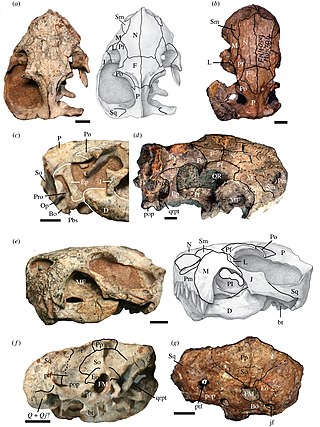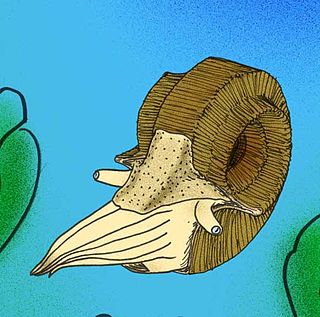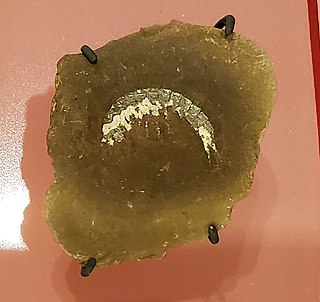
The Trachypachidae are a family of beetles that generally resemble small ground beetles, but that are distinguished by the large coxae of their rearmost legs. There are only six known extant species in the family, with four species of Trachypachus found in northern Eurasia and northern North America, and two species of Systolosoma in Chile and Argentina. They were much more diverse in the past, with dozens of described species from the Mesozoic.

Helicoprion is an extinct genus of shark-like eugeneodont fish. Almost all fossil specimens are of spirally arranged clusters of the individuals' teeth, called "tooth whorls", which in life were embedded in the lower jaw. As with most extinct cartilaginous fish, the skeleton is mostly unknown. Fossils of Helicoprion are known from a 20 million year timespan during the Permian period from the Artinskian stage of the Cisuralian to the Roadian stage of the Guadalupian. The closest living relatives of Helicoprion are the chimaeras, though their relationship is very distant. The unusual tooth arrangement is thought to have been an adaption for feeding on soft bodied prey, and may have functioned as a deshelling mechanism for hard bodied cephalopods such as nautiloids and ammonoids. In 2013, systematic revision of Helicoprion via morphometric analysis of the tooth whorls found only H. davisii, H. bessonowi and H. ergassaminon to be valid, with some of the larger tooth whorls being outliers.

The Lopingian is the uppermost series/last epoch of the Permian. It is the last epoch of the Paleozoic. The Lopingian was preceded by the Guadalupian and followed by the Early Triassic.

In the geologic time scale, the Changhsingian or Changxingian is the latest age or uppermost stage of the Permian. It is also the upper or latest of two subdivisions of the Lopingian Epoch or Series. The Changhsingian lasted from 254.14 to 251.9 Ma ago. It is preceded by the Wuchiapingian age/stage and is followed by the Induan age/stage.

Euchambersia is an extinct genus of therocephalian therapsids that lived during the Late Permian in what is now South Africa and China. The genus contains two species. The type species E. mirabilis was named by paleontologist Robert Broom in 1931 from a skull missing the lower jaw. A second skull, belonging to a probably immature individual, was later described. In 2022, a second species, E. liuyudongi, was named by Jun Liu and Fernando Abdala from a well-preserved skull. It is a member of the family Akidnognathidae, which historically has also been referred by as the synonymous Euchambersiidae.

Araxoceras is an extinct genus of ceratitid ammonites that lived in the Late Permian marine environments of Iran, South China and Japan. The various species had distinctive, angular-cornered shells.

Endothiodon is an extinct genus of medium to large dicynodont from the Late Permian. Like other dicynodonts, Endothiodon was an herbivore, but it typically lacked the two tusks that characterized most other dicynodonts and instead had long rows of teeth inset in the jaws that replaced in waves. The anterior portion of the upper and lower jaw are curved upward, creating a distinct beak that is thought to have allowed them to be specialized grazers.

Dasyleptus is an extinct genus of wingless insects in the order Archaeognatha, and the only member of the family Dasyleptidae. They resembled their modern relatives and had a single lengthy filament projecting from the end of the abdomen. They also had a pair of leg-like cerci and some non-ambulatory abdominal appendages. The largest specimens reached 30 millimetres (1.2 in) or more, not counting the length of the filament. Dasyleptus was formerly placed in its own extinct order, Monura, but this is now treated as a suborder of Archaeognatha.
Wangwusaurus is extinct genus of probable therapsid that lived in the Late Permian in present-day China. Only species is known, Wangwusaurus tayuensis, described by the paleontologist Yang Zhongjian in 1979 from seventeen teeth found in the Jiyuan formation, of which at least seven are recognized as not belonging to those of therapsids.
Ingentidens is an extinct genus of chroniosuchid reptiliomorph from upper Permian mudstone deposits of Dashankou locality, Xidagou Formation of China. It was first named by Jin-Ling Li and Zheng-Wu Cheng in 1999, from a mandible. The type species is Ingentidens corridoricus. The generic name means “large” + “tooth” (dens), and the specific name referring to the region of Gansu, the Hexi Corridor where the type specimen was found.
Phratochronis is an extinct genus of chroniosuchid reptiliomorph from upper Permian mudstone deposits of Dashankou locality, Xidagou Formation of China. It was first named by Jin-Ling Li and Zheng-Wu Cheng in 1999, from a maxilla and premaxilla with almost complete dentition. The type species is Phratochronis qilianensis. The generic name means “brothers of a clan” + “late” in reference to its taxonomic position, and the specific name referring to the chain of mountains where the type specimen was found.

Macroolithus is an oogenus of dinosaur egg belonging to the oofamily Elongatoolithidae. The type oospecies, M. rugustus, was originally described under the now-defunct oogenus name Oolithes. Three other oospecies are known: M. yaotunensis, M. mutabilis, and M. lashuyuanensis. They are relatively large, elongated eggs with a two-layered eggshell. Their nests consist of large, concentric rings of paired eggs. There is evidence of blue-green pigmentation in its shell, which may have helped camouflage the nests.
Gansurhinus is an extinct genus of moradisaurine captorhinid known from the Middle Permian Qingtoushan Formation of the Qilian Mountains and the Late Permian Naobaogou Formation in the Daqing Mountains of China. It was first named by Robert R. Reisz, Jun Liu, Jin-Ling Li and Johannes Müller in 2011 and the type species is Gansurhinus qingtoushanensis. A second species, Gansurhinus naobaogouensis, was described in 2023 based on a relatively complete skeleton of an immature individual.
Kingoceras is a genus of ammonoids in the order Ceratitida and family Paraceltitidae which lived during the Late Permian from about 265 to about 254 million years ago. The shell is thinly lenticular, sutures are goniatitic and have only eight fully distinct lobes.
Doulingoceras is a genus of ammonoid within the ceratitid order, found in China, that lived during the Late Permian during the time span from about 260.5 to 254 million years ago. The genus is included in the family Paraceltitidae, which belongs to the superfamily Xenodiscaceae.
Syops is an extinct genus of dicynodont therapsid. The type species S. vanhoepeni was first named in 1938 as Dicynodon vanhoepeni. Fossils of the genus have been found in the Cistecephalus Assemblage Zone in the Usili Formation of the Ruhuhu Basin, Tanzania and the Upper Madumabisa Mudstone Formation of the Luangwa Basin, Zambia. Its phylogenetic placement is somewhat uncertain, with multiple different studies finding it as either a basal geikiid, rhachiocephalid a dicynodontoid more derived than the most basal genera but less derived than Lystrosauridae, or a lystrosaurid.
Kunpania is an extinct genus of dicynodont therapsid from the Quanzijie Formation of Xinjiang, China. The type and only species is K. scopulusa, and it is known only by a single incomplete specimen including parts of the skull and forelimb. Since its initial description in 1978 by palaeontologist Ailing Sun, it has sometimes been considered to be another species of Dicynodon by other researchers, or potentially undiagnostic. However, a redescription in 2021 reaffirmed its distinctiveness, including a uniquely well developed muscle attachment on the humerus. Kunpania is perhaps the oldest known member of the derived dicynodont group Dicynodontoidea, potentially dating to the Middle Permian period during the Capitanian, and so may fill a knowledge gap in the history of dicynodont evolution.

Baiera is a genus of prehistoric gymnosperms in the order Ginkgoales. It is one of the oldest fossil foliage types of Ginkgoales, and is related to the genera Ginkgo and Ginkgoites. Fossils of Baiera are found worldwide, and have been known from the Permian to the Cretaceous.

Counillonia is an extinct genus of dicynodont therapsid from the area of Luang Prabang in Laos, Southeast Asia that lived at around the time of the Permian-Triassic boundary and possibly dates to the earliest Early Triassic. Its type and only known species is C. superoculis. Counillonia was related to the Triassic dicynodonts such as Lystrosaurus and the Kannemeyeriiformes that survived the Permian mass extinction, but it was more closely related to the Permian genus Dicynodon than to either of these lineages. Counillonia may then possibly represent another line of dicynodonts that survived the Permian mass extinction into the Triassic period, depending on its age. The discovery of Counillonia in Laos and its unexpected evolutionary relationships hint at the less well understood geographies of dicynodont diversity across the Permo-Triassic boundary outside of well explored regions like the Karoo Basin in South Africa.
Taoheodon is an extinct genus of dicynodont therapsid from the Sunjiagou Formation in the Shanxi province of China, dated to the Wuchiapingian age of the Late Permian. Its type and only known species is T. baizhijuni. Taoheodon was a close relative of the well known Dicynodon, and may represent a biogeographical link between the South African Dicynodon and similar dicynodonts found in Laos.










